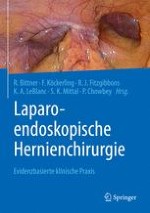Zusammenfassung
Die Leistenhernie ist ein häufig auftretendes Krankheitsbild. Während das operative Vorgehen hoch standardisiert ist, wird die Nachsorge eher individualisiert gehandhabt. Dabei braucht gerade die Nachsorge ein einheitliches Regime, um hieraus individualisierte Konzepte herauszuarbeiten. Im Vordergrund stehen eine suffiziente peri- und postoperative Schmerzprophylaxe sowie eine befundadaptierte klinische und bildmorphologische Nachkontrolle. Hierbei dient der Ultraschall als obligates Hilfsmittel, um postoperative Ereignisse frühzeitig zu detektieren. Führt dieser zu keinem Ergebnis, ist das MRT ein nächster durchzuführender Untersuchungsschritt. Therapierefraktäre Schmerzen, die länger als 3 Monate bestehen, benötigen ein gesondertesTherapiekonzept.














